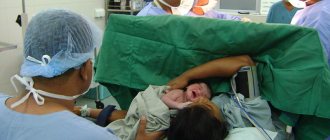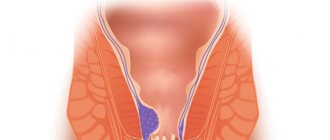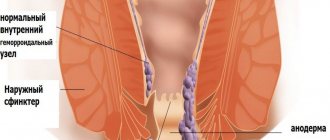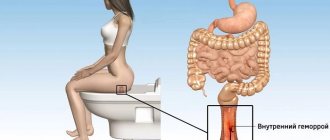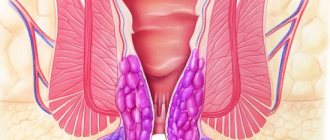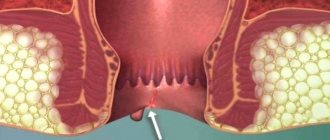Hemorrhoids are even more dangerous during pregnancy
Hemorrhoids often accompany pregnancy; according to statistics, every second expectant mother suffers from this disease. Symptoms may be absent until the very last moment, and during childbirth the situation can sharply worsen. Many pregnant women ask the question: is it possible for a woman to give birth with hemorrhoids? In order to prevent complications during childbirth, it is very important to pay attention to the treatment and prevention of hemorrhoidal disease throughout pregnancy. With successful treatment of hemorrhoids, future childbirth and everything associated with it will be much easier and safer.
What are the dangers of hemorrhoids during childbirth and is it possible to give birth with them?
Hemorrhoids are not an indication for refusal to have a natural birth. But this does not mean that during childbirth the problem will not worsen and complications will not arise. Therefore, during pregnancy, it is important to do everything to minimize the causes and symptoms of the disease, so as not to wonder in the future: hemorrhoids during childbirth - how to give birth?
The disease may first appear during pregnancy. In this case, it is important not to delay treatment; the use of modern medications allows you to quickly and effectively cope with the pathology at the initial stage of its development. The main thing is to know the main reasons for the development of hemorrhoids and eliminate possible risk factors.
If the disease is not treated, hemorrhoids can cause the following complications during childbirth:
- bleeding, sometimes requiring emergency care;
- infection and strangulation of hemorrhoids;
- development of thrombophlebitis;
- transition of the chronic form of the disease to acute, with further development of necrosis of nodes and paraproctitis.
The most dangerous thing is untreated hemorrhoids during childbirth because there is a risk of bleeding followed by significant blood loss.
Treatment of hemorrhoids in pregnant women
Hemorrhoidal disease requires mandatory treatment and strict adherence to medical instructions. Untreated hemorrhoids can cause adverse events during childbirth. Childbirth and advanced hemorrhoids may be accompanied by:
- Bleeding that may lead to the need for a blood transfusion;
- Strangulation of hemorrhoids;
- Exacerbation of thrombophlebitis;
- Progression of the disease and transition from chronic to acute form;
- The appearance of paraproctitis and necrosis of hemorrhoidal cones (the most severe forms of the disease).
Taking medications during pregnancy has significant limitations, especially in the first and second trimester. This is due to a possible risk to the fetus. The drugs used must be completely natural or have minimal side effects.
Causes
There are 5 main causes of hemorrhoids. Sometimes a woman may have several of them at the same time.
Tendency to constipation
Impaired intestinal motility due to poor nutrition leads to constipation. Chronic constipation, in turn, provokes congestion in the veins of the pelvis, which causes the development of hemorrhoids. Read more about constipation during pregnancy→
As a rule, the condition can be corrected by changing the diet and normalizing stool. Sometimes medication may be required.
Uterine growth
During pregnancy, the uterus gradually enlarges along with the growing fetus. As it grows, it puts increased pressure on the vessels and pelvic organs, including the intestines.
This leads to the development of constipation and congestion, which ultimately ends in hemorrhoids. To reduce the risk of the problem, it is recommended to avoid prolonged sitting.
Sedentary lifestyle
Insufficient physical activity, reluctance to exercise, and a sedentary lifestyle are a universal cause of the development of hemorrhoids both among expectant mothers and other people.
Most women during pregnancy try to limit their activity in every possible way, justifying this by poor health, discomfort in the abdomen and lower back. This behavior negatively affects the blood circulation in the pelvic organs, which leads to the formation of hemorrhoidal nodular changes.
Hormonal imbalance
A woman's body undergoes many changes during pregnancy, including hormonal changes. For example, an increased level of progesterone in the blood, necessary to maintain and preserve pregnancy, has a side effect on the pelvic vessels - it contributes to their pathological expansion.
Also, a hormonal storm in the body of the expectant mother causes constipation. If we add to these factors poor nutrition and a sedentary lifestyle, then the combination of these criteria leads to hemorrhoids in almost 100% of cases.
Childbirth
Labor activity for every woman is caused by high physical load on the pelvic organs. If before the birth of the child the expectant mother experienced initial symptoms of hemorrhoids, which she might not even notice, then, in most cases, after childbirth the pathology will make itself felt or worsen. This is why prevention of hemorrhoids in pregnant women is important.
If a woman is healthy, then the likelihood of hemorrhoids appearing after childbirth is minimal.
Do you still think that getting rid of hemorrhoids is difficult?
Judging by the fact that you are now reading these lines, victory in the fight against hemorrhoids is not yet on your side.
Have you already thought about surgery? This is understandable, because you have only one internal body, and its proper functioning is the key to health and well-being. Blood on paper, constant thoughts of how to reduce swollen, painful lumps, insomnia, going to the toilet feels like hard labor. All these symptoms are familiar to you firsthand.
But perhaps it would be more correct to treat not the effect, but the cause? We recommend reading the story of Mikhail Sergeevich, how you can get rid of hemorrhoids without harming yourself. Read the article >>
Unfortunately, during pregnancy a woman will have to face many difficulties and unpleasant phenomena. It does not happen that the entire gestation period goes smoothly, without a hitch. Expectant mothers experience a wide variety of troubles: the appearance of age spots, the formation of stretch marks on the skin, exacerbation of diseases of the genitourinary system, etc., etc. Hemorrhoids deserve a separate discussion.
Hemorrhoids often appear for the first time during pregnancy. If a woman had this problem in the past, then it will almost certainly make itself felt now. There are often cases when hemorrhoids form after childbirth - due to the load on the rectum and anus, which is inevitable during pregnancy and childbirth. But it seems that the worst thing is if hemorrhoids worsen a few days or weeks before the baby is born.
Symptoms
Bleeding after bowel movements is one of the main symptoms of hemorrhoids. Blood loss can range from blood on toilet paper to severe bleeding requiring emergency treatment. The disease is also characterized by the presence of itching, burning and discomfort in the anal area. Pain does not occur in all cases; usually pain during bowel movements and at rest appears only at the stage of exacerbation of the disease.
Prolapse of hemorrhoids is the second striking symptom of hemorrhoids. At the initial stage of the disease, the nodules come out of the anal sphincter along with the stool; you can straighten them yourself. Later, the nodes have to be adjusted more and more often, because as the pathology progresses, the muscle tone of the sphincter weakens and cannot hold the nodes in the rectum for a long time.
Hemorrhoids, like any other disease, occur in acute and chronic forms. In the first case, the pathology is accompanied by sharp pain, in particular during defecation, while walking and even with slight physical activity.
The chronic form of hemorrhoids is characterized by minor pain in the anus, often appearing during bowel movements and disappearing after it, light and rare bleeding after stool and periodic prolapse of hemorrhoids.
Hemorrhoids after cesarean section
Caesarean section relieves women in labor from intense pushing. Therefore, the probability of exacerbation of the disease does not exceed 15%. However, there are cases when, even after an easy and quick birth, new mothers feel pain. The thing is that during the period of bearing a child, the disease gradually progresses. But at the time of natural childbirth, the body’s resistance to new symptoms increases, and pain disappears, experts explain. The same cannot be said about the caesarean section procedure. During this period, the body's adaptive capabilities deteriorate, so discomfort cannot be avoided.
After childbirth, it is extremely important for women not to break bed rest. Otherwise, the likelihood of blood stagnation in the rectum increases, and hemorrhoidal seals can double in size.
Treatment
If a woman is diagnosed with hemorrhoids before giving birth, what should she do? Of course, it can be treated during pregnancy, and therapy must be started on time. In this case, the expectant mother has a greater chance of a favorable outcome for this disease.
Firstly, it is necessary to correct the functioning of the intestines, eliminating constipation. This can be done with the help of an appropriate diet and moderate physical activity aimed at maintaining muscle tone of the perineum and abdominal wall, which allows you to get rid of congestion in the pelvic organs.
And, secondly, treatment of hemorrhoids during pregnancy depends on the stage of the disease. For this reason, all expectant mothers suffering from this pathology are divided into two groups.
Group 1 - women with asymptomatic hemorrhoids detected in the early stage of development during a random medical examination. Such patients do not receive drug treatment; they are recommended only preventive measures: diet, physical therapy, walking, and, if necessary, laxatives are prescribed.
Group 2 - women with chronic constipation, burning and itching in the rectum, bleeding and pain during bowel movements. Treatment in this case is medicinal, the selection of drugs is carried out individually by an experienced proctologist. Read more about drugs for the treatment of hemorrhoids during pregnancy→
During pregnancy, hemorrhoids are treated with the same drugs in the form of ointments, suppositories and gels that are prescribed to all patients:
- to reduce vascular permeability and capillary fragility, as well as to eliminate inflammation, Troxevasin, Ginkor-forte, Troxerutin are used;
- to reduce blood viscosity and increase vascular tone, Doxium, Gepatrombin, Aescusan are prescribed;
- Venitan and Misvengal are recommended for analgesic and antipruritic purposes.
If hemorrhoids during pregnancy are combined with the presence of an anal fissure, it is also advisable to leave the choice to conservative therapy. If surgical treatment is necessary, doctors resort to the most gentle interventions aimed at preventing bleeding.
Approved drugs for the treatment of hemorrhoids in pregnant women
The most common means are:
- Troxevasin (strengthens the walls of blood vessels);
- Troxerutin (eliminates inflammation);
- Doxium (thins the blood and increases vascular tone);
- Heparin ointment (dissolves blood clots, reduces inflammation, relieves pain, plus everything has a low cost);
- Ichthyol ointment (effectively anesthetizes and eliminates foci of inflammation, heals wounds in the anal area);
- Posterizan forte in the form of ointments and suppositories;
- Candles with calendula, propolis or sea buckthorn;
- Suppositories with papaverine (an absolutely harmless remedy during pregnancy);
- Bezornil (this drug is prescribed extremely rarely, only when other drugs do not have the required effect).
A prerequisite for obtaining an effective treatment result is a properly balanced diet and adherence to a diet. Traditional medicine can also help pregnant women. She offers treatment for hemorrhoidal disease using herbal decoctions and infusions of nettle, chamomile, and dandelion. They are used to wash the rectal area. Compresses and lotions made from beets and grated potatoes are effective. A correctly selected treatment regimen will help to significantly reduce the manifestation of symptoms and eliminate the doubts of many expectant mothers: “is it possible to give birth with hemorrhoids?” If you get rid of hemorrhoids in a timely manner, the upcoming birth will not be a cause for great concern.
How does childbirth occur with hemorrhoids?
Hemorrhoids and childbirth are a completely compatible phenomenon, since doctors do not consider this disease a contraindication for natural childbirth. Only the chronic form of hemorrhoids is an indication for cesarean section if we are talking about the 4th degree of pathology.
Surgical delivery for hemorrhoids is recommended for women if they have heavy bleeding and thrombotic nodes. But this happens quite rarely. In any case, the decision on the nature of delivery is made individually, after examining the woman by a proctologist.
But it should be noted right away that childbirth with hemorrhoids is not the most successful combination. Most likely, the presence of hemorrhoids will affect the duration of labor and, to some extent, its pain. In addition, childbirth can aggravate the course of the disease, since it involves intense tension in the muscular system of the pelvis and perineum, which means that the load will fall on the vessels, sphincter and rectum.
Depending on how the birth went, one can judge the consequences of the pathology. The quick and easy birth of a child may have virtually no effect on the course of hemorrhoids.
Prolonged labor with prolonged and intense pushing usually leads to serious complications. During such births, the disease can appear even in those women who have not previously encountered this pathology.
Moving along the birth canal, the fetus compresses the mother's blood vessels and pelvic organs. If the condition of the hemorrhoids in a woman in labor is unsatisfactory, then with pushing they can fall out through the anal sphincter.
Most often, further contraction of the sphincter returns them to their proper place, sometimes the midwives “tuck” the nodes back. In rare cases, during natural childbirth with hemorrhoids, nodes become pinched, resulting in the development of an acute form of the disease.
Is it possible to avoid exacerbation of hemorrhoids during childbirth? If the disease already exists and labor has begun, it is almost impossible to influence the situation. The woman can only listen and follow all the instructions of the midwife and doctor. Timely and competent actions during the pushing period, without additional tension of the perineal muscles, are the right path to a safe and easy birth, without such consequences as ruptures and hemorrhoids.
Indications for caesarean section
Sometimes Caesarean section is the only option
Natural childbirth with hemorrhoids is, of course, desirable, but not always possible. The presence of hemorrhoids complicates childbirth. If thrombotic nodes are present, surgery may be prescribed to remove them before delivery. It is done only under local anesthesia.
Bleeding hemorrhoids interfere with labor and are a common reason for caesarean section.
Childbirth with bleeding hemorrhoids is associated with the risk of serious consequences for the mother in labor. There is a high probability of significant blood loss during natural childbirth. The decision about whether it is possible to give birth with hemorrhoids naturally or whether it is necessary to resort to surgical intervention is finally made after examination by a proctologist.
Postpartum activities
Treatment of hemorrhoids after childbirth is carried out in two ways. The first method is based on conservative therapy, the second method is surgical treatment. It all depends on how the disease progresses. You should not be afraid of surgical treatment, since modern techniques such as sclerotherapy, infrared coagulation and latex ligation of nodes are low-traumatic interventions that guarantee a successful recovery.
It is not recommended to diagnose yourself and treat hemorrhoids at home without the participation of a doctor. If the problem is detected early, treatment is faster and more effective.
There are many effective drugs aimed at treating this pathology. Therefore, childbirth and hemorrhoids, when combined, are not currently a serious problem. The main thing is to promptly consult a doctor for help if signs of disease development are detected.
Author: Olga Rogozhkina, doctor, especially for Mama66.ru
Possible problems after childbirth
After natural childbirth, the possibility of hemorrhoids is still present. Since this pathology develops very quickly, you should not turn a blind eye to the problem. At the first manifestations of the disease, it is necessary to urgently consult a specialist. It will help you choose effective and efficient medications and avoid further development of the disease. During lactation, it is permissible to use all ointments, gels and suppositories usually prescribed during pregnancy.
Caesarean section in patients with acute or chronic hemorrhoids
In the first stages of the disease, it is allowed to give birth naturally.
The indication for cesarean section for hemorrhoids in the initial stages is not mandatory. Natural labor attempts and the movement of the fetus along the birth canal increase intra-abdominal pressure, straining the abdominal muscles and squeezing the intestinal veins. Hemorrhoids complicate childbirth, increase its pain and duration.
If severe complications develop, a cesarean section for hemorrhoids is mandatory. The main indication for its use is grade 4 hemorrhoids. Natural childbirth at this stage of the disease is dangerous, because during labor, the nodes, overflowing with blood from high pressure, rupture and bleed profusely. Rapid contraction of the anal muscles provokes compression of the nodes and their prolapse outward.
Abdominal surgery is performed if the following signs of illness are present:
- blockage of nodes;
- the presence of pathogenic bacteria and fungi;
- prolonged and heavy bleeding;
- necrosis of tissues of the gastrointestinal tract.
The use of cesarean section for hemorrhoids:
- prevents increased pressure during childbirth on internal organs and blood vessels;
- prevents the worsening of the pathological condition;
- prevents blood stagnation.
The causes of hemorrhoids develop in women during pregnancy before surgery. The disease is partly promoted by physiological factors of hormonal changes, but non-compliance with physical activity and diet is more significant.
The hormones progesterone and estrogens “manage” pregnancy and prepare for childbirth. Progesterone levels increase 20 times from the first trimester. Its task is to ensure the fixation of the fertilized egg and prevent contractions of the muscular layer of the uterus. This requires relaxation of smooth muscles. At the same time, the venous network and intestinal muscles fall under the action of the hormone.
The caverns lose their tone and elasticity, their ability to pump out blood. This promotes stagnation and enlargement of the buds. Atony of the muscles of the large intestine causes constipation. A woman is forced to strain during bowel movements, which increases the volume of blood flow, but complicates the outflow.
2 weeks before birth, the amount of progesterone decreases rapidly. Estrogens and oxytocin prepare the uterus for contractile function. Vascular tone also increases. Therefore, after natural childbirth, the bumps disappear on their own, and blood flow is restored. But for patients with severe hemorrhoids, the operation is performed before the planned date of birth. Their hormonal changes do not have time to develop at the required level.
Opening the uterus during a caesarean section requires suturing the incision of three layers of tissue after removing the fetus and placenta. To ensure healing and complete formation of a scar on the uterus, a woman needs a long recovery period. Physical activity and any tension in the abdominal muscles are contraindicated. Bed rest is recommended. The recommendations contribute to stagnation in hemorrhoidal structures and further increase constipation.
The surgical technique is accompanied by the temporary application of clamps to the blood vessels, which affects the blood supply to the pelvic organs. We cannot exclude the possibility of increased blood pressure and an additional negative reaction of the body to stress.
Anesthetic substances used for anesthesia have a depressing effect on intestinal muscle tone. They are completely removed from the body after a week, so in the first days after surgery they impede intestinal motility and contribute to constipation.
A temporary increase in the absorption capacity of liquid by the intestinal epithelium is important. As a result, feces acquire a hard consistency, are not able to move quickly through the intestines, and injure the surface and wall of the nodes
A forced lying position slows down blood flow in the pelvic organs, which causes oxygen deficiency and suspends metabolism in cells. The venous vessels of the rectum find themselves in an unfavorable area. The process of restoring elasticity and outflow is disrupted.
The given features of the body of women after surgery are taken into account when prescribing complex treatment for hemorrhoids.
To cure hemorrhoids, you must consult a doctor. Self-medication can be ineffective and dangerous for the health of mother and baby. Breastfeeding places certain restrictions on drug therapy, and fresh stitches eliminate physical activity. But a specialist will tell you how to properly treat hemorrhoids, especially after a cesarean section, in order to protect the patient and her baby as much as possible from unpleasant consequences.
Bed rest
The rehabilitation stage requires the woman to remain strictly in bed. This can cause congestion in the blood vessels and worsen the situation. To avoid this, it is necessary to ensure that the patient is positioned so that her lower body is higher than her upper body. In this case, you should place a bolster or pillow under your pelvis and legs. This position will ensure the outflow of blood from the pelvic organs and reduce pressure on the vessels.
If the caesarean section went without complications, then after a day the doctor may advise you to get out of bed and move around within the ward. In the future, as the mother’s condition improves, light exercises are used. The most common is Kegel gymnastics. It consists of rhythmic contraction of the muscles of the perineum.
What medications a doctor will prescribe for the treatment of hemorrhoids depends on whether the woman is breastfeeding her baby. If breastfeeding occurs, then the list of medications that can cure the disease is significantly reduced
Please pay attention to the following recommendations:
- It is necessary to be very careful when choosing medications, because many of them are contraindicated when feeding. This is due to the fact that some components of the drugs cause allergies in the child.
- For a nursing woman, topical medications are more suitable: suppositories or ointments for hemorrhoids. They have less impact on the child’s body and are therefore safer.
- It is better to give preference to medications based on natural ingredients.
- You need to get rid of constipation. To do this, use lactulose laxatives or microenemas, which soften hardened stool. Sometimes a regular enema may be necessary. It is best to prepare it using medicinal herbs. You should not overuse enemas, as they help wash out the intestinal microflora. This is fraught with the formation of even more severe constipation.
- To prevent constipation, it is necessary to adjust your diet. To do this, you need to eat as much fiber as possible, drink clean still water in a volume of about two liters.
- You can use herbal baths. The best choice is string and chamomile.
If hemorrhoids have reached a severe stage, surgical intervention is used to treat them. Such therapy causes certain difficulties for a nursing woman, since the use of many anesthetics is unsafe for the baby.
Most often, in this case, minimally invasive techniques are used, including:
- Laser removal of hemorrhoidal cones.
- Freezing nodes with liquid nitrogen.
- Latex rings for tying knots.
In order not to resort to surgical treatment of hemorrhoids, you need to consult a doctor when the problem is not yet of such a large-scale nature.
Rehabilitation
In order to avoid the development of hemorrhoids as effectively as possible after a cesarean section, you need to start moving quickly. If the doctor allows it, then within a day after the operation you should get out of bed and move around the room. It is necessary to resume movements gradually, starting from a flat surface. You can resort to special light aerobics, exercises, and suture removal aimed at eliminating delicate problems.
The safest components that will help cope with hemorrhoids are considered to be medicinal herbs. They can be used as baths, compresses, microenemas. You just need to remember that herbal medicine is effective as an additional treatment, and before using it, you also need to consult a doctor.
Acute hemorrhoids - occurs in a previously healthy pregnant woman. The suddenness shortly before birth significantly worsens the situation. The patient experiences severe pain and swelling of the perineum, prolapsed nodes are bluish, which indicates thrombosis. When black spots appear, the stage of necrosis is suspected. The subsequent addition of inflammation threatens the mother and fetus with sepsis. Therefore, removal of necrotic masses for emergency reasons, detoxification, and transfusion of blood substitutes are required.
In such cases, a cesarean section helps to remove the baby and prevent negative effects from the mother’s body. You cannot stimulate your own labor due to the danger of pushing. After the operation, the woman is actively treated with antibiotics and anticoagulant drugs.
For chronic hemorrhoids in a pregnant woman, surgery is prescribed for similar indications. In the fourth stage, the pathology is accompanied by infection of surrounding tissues, thrombosis and bleeding.
If the condition of hemorrhoids is determined as stage II–III without complications, then the woman is allowed to give birth naturally. Further treatment of hemorrhoids depends on the timely visit of the postpartum mother to a proctologist, the effectiveness of the prescribed medications, and the implementation of recommendations on diet and regimen.
Pregnant women should have a clear understanding of the manifestations and complications of hemorrhoids. Signs of illness do not necessarily mean the use of surgical delivery. Correct behavior and therapeutic measures help to bear and give birth to a healthy child, and in the future, purposefully resolve the issue of optimal treatment of hemorrhoids with your doctor.
Many people believe that the expansion of hemorrhoidal veins is caused by a woman’s improper behavior during pushing, but the disease often occurs after surgery. This is explained by the following factors:
- The presence of the initial stage of hemorrhoids during pregnancy. Exacerbation of the disease after surgery is facilitated by adherence to bed rest, which disrupts the blood supply to the pelvic organs.
- Constipation. The difficulty of bowel movement is caused by pain that occurs when the abdominal muscles are tense. Stagnation of feces is the main cause of the formation and inflammation of hemorrhoids.
- Pressure of the growing uterus on the veins of the rectum, complicating the outflow of blood.
- An increase in progesterone levels, necessary for the normal course of pregnancy. Causes a decrease in vascular tone, which, in combination with increased intra-abdominal pressure, leads to stretching of the venous walls.
- Postoperative complications.
Stagnation of feces is the main cause of the formation and inflammation of hemorrhoids.
